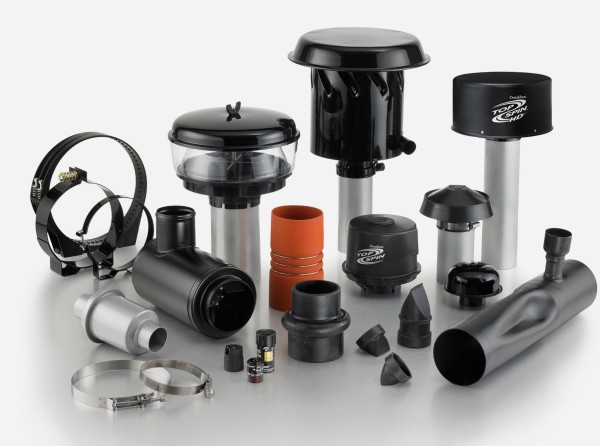When operating equipment in wet weather conditions, it is common for excess moisture to be drawn into the air intake system. This is particularly common in on-highway equipment which often operates at high speed in very wet weather.
Unfortunately, this moisture can have some undesirable effects, including:
- Giving higher restriction readings
- Causing any residual dust to cake into mud
- Causing blocked vacuator valves
- Saturating some of the filter media
- Corrosion or water damage to intake system
There are a number of steps you can take to reduce, or even eliminate the impact of wet weather operation. There are also ways of preventing much of the moisture in the incoming air from entering the air cleaner.

For on-highway applications, the use of an air ram will help to eliminate much of the excess water as the air is drawn into the intake.
For off-road equipment, the use of a good quality rain cap or stack-top moisture eliminator will remove up to 80% of moisture from incoming air.
An inline separator, mounted before the air cleaner will also remove up to 80% of the moisture (and up to 70% of dust in dry conditions!) from the incoming air and is suitable for both on and off road vehicles.
Another option is to install an in-line moisture skimmer, designed to fit in a horizontal position before the air cleaner.
None of these moisture reducing devices have any moving parts. They are virtually maintenance free, other than an occasional inspection during servicing. All will remove most of the incoming water from moisture laden air, giving longer filter life, reduced operating costs and better performance.
Did You Know?
If your restriction indicator has locked at the maximum restriction level after operating in wet conditions, it needs servicing. To service the indicator, remove, clean and dry the indicator. Reset it and apply a small amount of vacuum. If it locks up again, reset and refit it. If it does not lock, you need to replace it.

Checklist
- Inspect your vac valve daily to ensure it is clear and undamaged. This is good practice regardless of the weather conditions.
- Ensure your air filter is installed correctly and that the cover of your air cleaner is fitted and sealing properly. Many air cleaners have a cover seal that may need replacing periodically if worn or damaged.
- Inspect your entire air intake system to ensure all seals are in good condition and are air tight. Any leaks before the air cleaner will draw water in, while any leaks after the air cleaner will allow contaminant to reach your engine resulting in costly repairs.

Minimizing Water in Air Intake Systems
Too much moisture entering an air intake system can cause damage to a vehicle’s crucial components. However, utilizing air intake accessories will help reduce the moisture from incoming air. This helps protect your air cleaner, prolonging filter life and engine durability while reducing maintenance costs.



